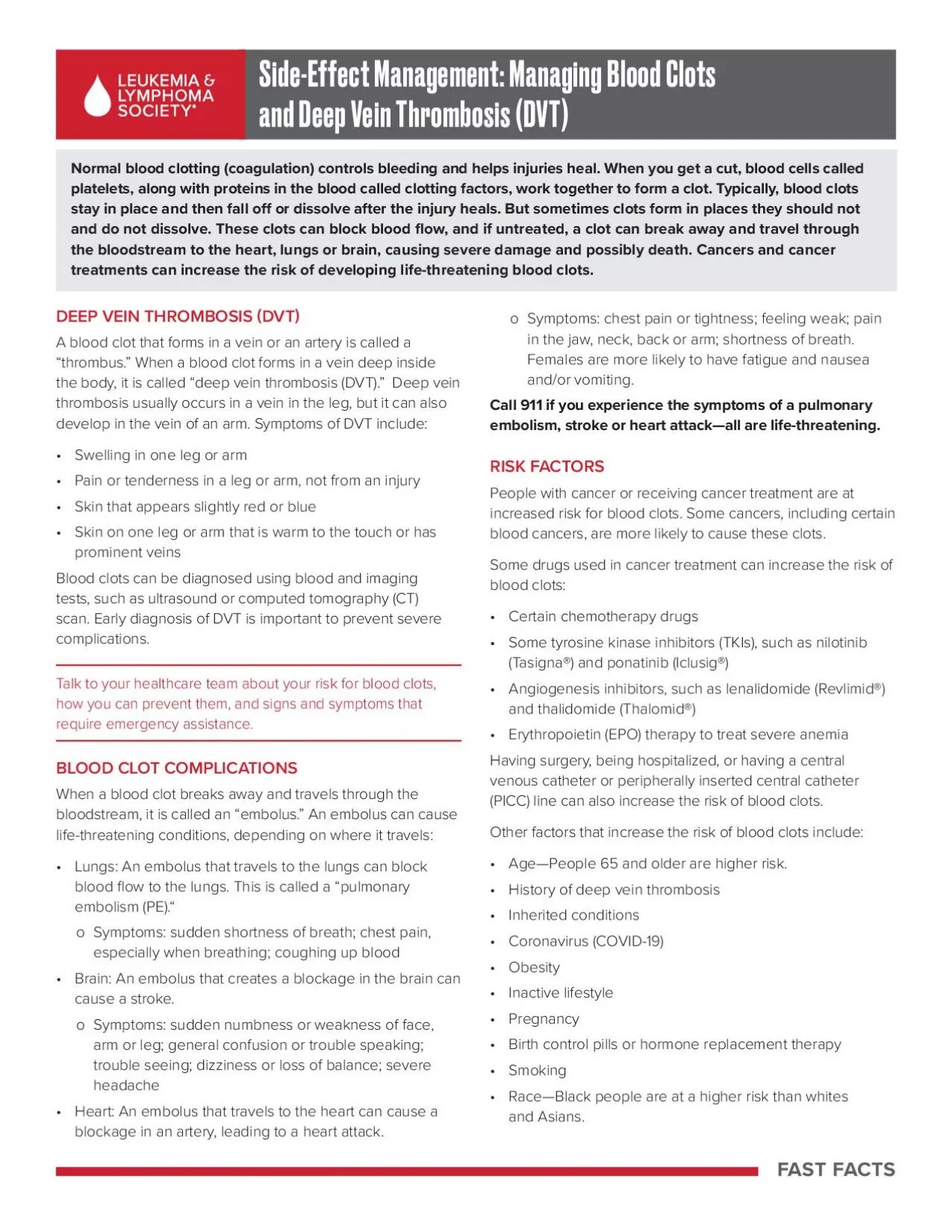

SideE31fect Management Managing Blood Clots and Deep Vein Thrombosis DVT DEEP VEIN THROMBOSIS 31DVT30A blood clot that forms in a vein or an artery is called a 147thrombus148 When ID: 940612
Download Pdf The PPT/PDF document "Normal blood clotting coagulation contro..." is the property of its rightful owner. Permission is granted to download and print the materials on this web site for personal, non-commercial use only, and to display it on your personal computer provided you do not modify the materials and that you retain all copyright notices contained in the materials. By downloading content from our website, you accept the terms of this agreement.
Normal blood clotting (coagulation) controls bleeding and helps injuries heal. When you get a cut, blood cells called platelets, along with proteins in the blood called clotting factors, work together to form a clot. Typically, blood clots stay in place and then fall o or dissolve after the injury heals. But sometimes clots form in places they should not and do not dissolve. These clots can block blood ow, and if untreated, a clot can break away and travel through FAST FACTS Side-E fect Management: Managing Blood Clots and Deep Vein Thrombosis (DVT) DEEP VEIN THROMBOSIS DVT A blood clot that forms in a vein or an artery is called a “thrombus.” When a blood clot forms in a vein deep inside the body, it is called “deep vein thrombosis (DVT).” Deep vein thrombosis usually occurs in a vein in the leg, but it can also develop in the vein of an arm. Symptoms of DVT include: Swelling in one leg or armPain or tenderness in a leg or arm, not from an injurySkin on one leg or arm that is warm to the touch or has Blood clots can be diagnosed using blood and imaging tests, such as ultrasound or computed tomography (CT) scan. Early diagnosis of DVT is important to prevent severe Talk to your healthcare team about your risk for blood clots, how you can prevent them, and signs and symptoms that require emergency assistance. BLOOD CLOT COMPLICATIONS When a blood clot breaks away and travels through the bloodstream, it is called an “embolus.” An embolus can cause life-threatening conditions, depending on where it travels: Lungs: An embolus that travels to the lungs can block blood ow to the lungs. This is called a “pulmonary embolism (PE).“Symptoms: sudden shortness of breath; chest pain, especially when breathing; coughing up blood Brain: An embolus that creates a blockage in the brain can cause a stroke. The mission of The Leukemia & Lymphoma Society (LLS) is to cure leukemia, lymphoma, Hodgkin’s disease and myeloma, www.LLS.org FF19 GET ONE-ON-ONE SUPPORTThe Leukemia & Lymphoma Society’s highly trained oncology social workers Clinical Trial Support Registered Dietitians.800.955.4572 Mon.-Fri. 9 a.m. to 9 p.m. (ET) www.LLS.org/PatientSupportPREVENTION AND TREATMENT The goal in treating DVT is to prevent the clot from getting larger or breaking loose. Preventi
on and treatment for DVT Anticoagulants (blood thinners): medications that help prevent and reduce clotting Thrombolytics (clot busters): emergency medications for stroke, heart attack, and pulmonary embolism Catheter-directed thrombolysis: a procedure in which a doctor guides a catheter (a long thin tube) into the blood Inferior Vena Cava (IVC) lter: inserted into the inferior vena cava (large vein that carries blood from the legs to the heart). The IVC lter catches clot fragments so they cannot travel to the heart or lungs. Surgery (thrombectomy) to remove a blood clot: this may be done when a clot becomes life-threatening and does not Daily aspirin therapy: this may help some blood cancer patients prevent blood clots from forming. Before taking check with your healthcare team. Blood cancer and treatment can cause a low number of platelets in the blood (thrombocytopenia), which can cause serious bleeding. Medications such as blood thinners and thrombolytics should be carefully considered and monitored. For tips to reduce risk of injury and bleeding, visit www.LLS.org/booklets to view Managing Low Blood Cell Counts. Other ways to help prevent DVT:Reach and maintain a healthy weight. Stay active. Avoid staying still for long, and don’t cross your legs. Elevate your legs when possible.Get up and move every hour when traveling on a plane, Stop and walk around at least every two hours when driving. While sitting, point and ex your toes and make circles with your feet to increase circulation. Drink a lot of water to stay hydrated. Wear loose- tting clothing when you travel. Wear compression (tight- tting) stockings to help prevent blood clots. Ask your doctor which style and grade of compression stockings you need. public service by The Leukemia & Lymphoma Society (LLS), with the Questions to Ask Your Healthcare TeamAm I at high risk for blood clots?Are blood clots a possible side effect of my cancer What can be done to prevent blood clots?Are there medications that can help? What signs or symptoms require a trip to the emergency room? Acknowledgement The Leukemia & Lymphoma Society (LLS) appreciates the Melissa Komlosi, MSN, RN, CPNP Clinical Trial Nurse NavigatorThe Leukemia & Lymphoma Society Leah Szumita MS, RN, CCRN, ACNS-BCDirector, Clinical Trial Support CenterThe Leukemia & Lymphoma Society